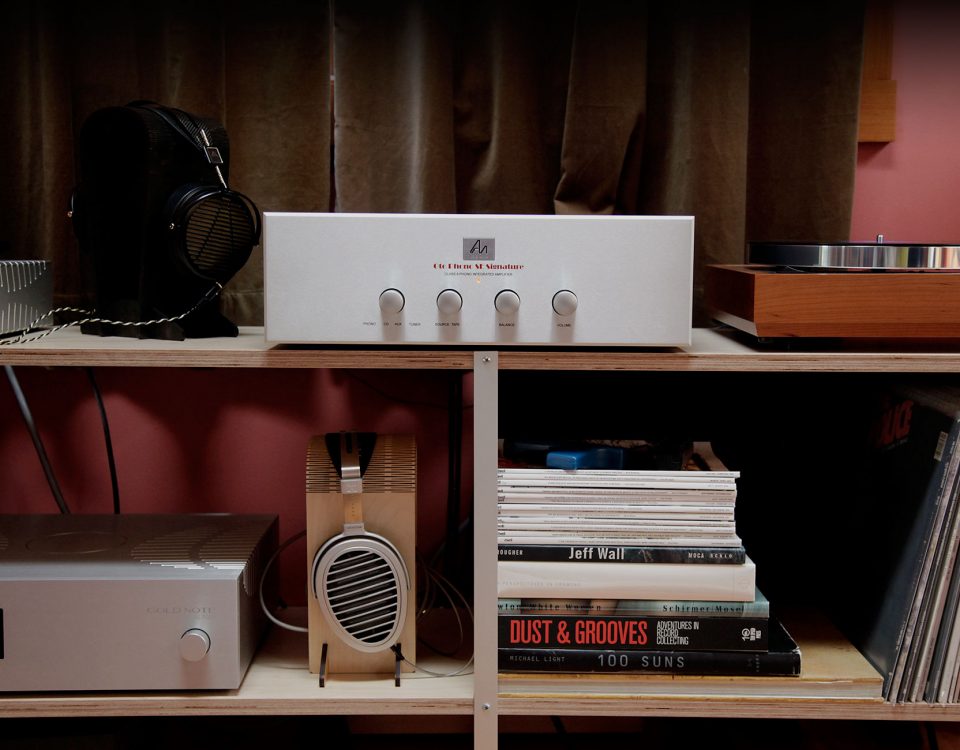Archetype: The Klipschorn – Iconic American Loudspeaker
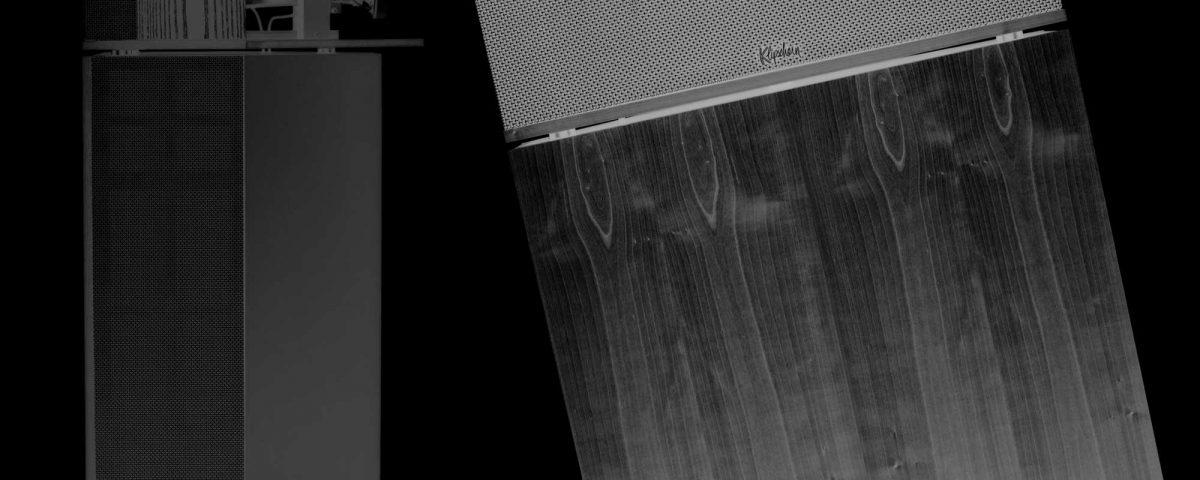
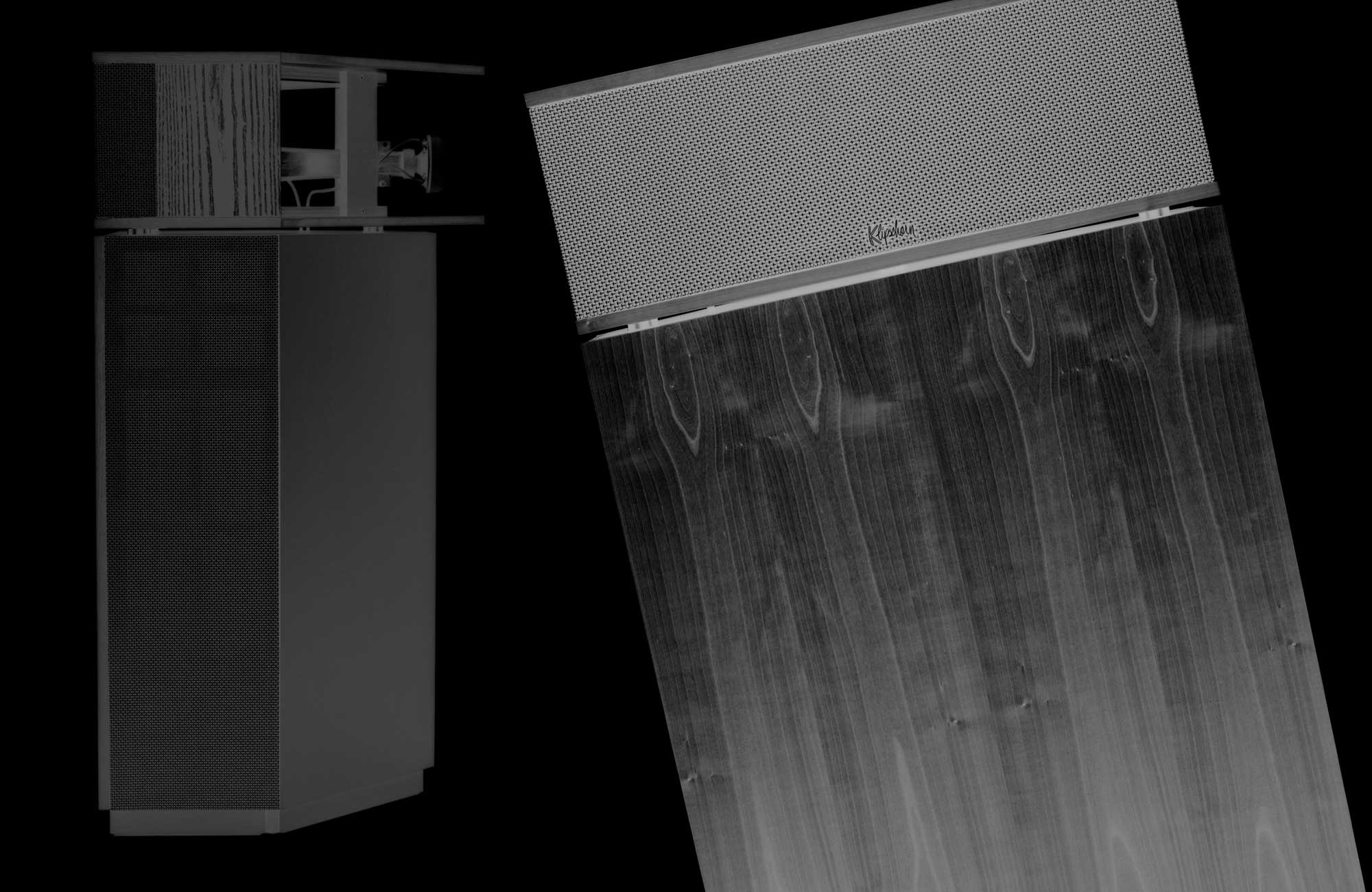

Words and photos by Rafe Arnott unless otherwise noted. Each column will examine an archetype of high fidelity and investigate its development, design, impact and legacy.
Much like legendary American industrial designers Charles and Ray Eames influenced all things midcentury modern, so too did Paul Klipsch impact high fidelity. Few, if any, modern audio engineers could profess ignorance of Klipsch’s groundbreaking folded-horn, corner-loading, three-way Klipschorn loudspeaker. Since it’s introduction in the late ‘40s, the K-horn has evolved into not only a sought-after example of high-efficiency speaker design, its iconic status in hi-fi circles has become cemented due to popularity: it’s the longest-running speaker in continuous production.
Getting a used pair of Klipschorn loudspeakers usually involves dumb luck, an irresistibly low price, a Craigslist ad, the borrowing of a truck or van, convincing friends to help move them and constantly reiterating that “there’s not much time.” This is because the seller is moving that day and there are invariably several other buyers converging on the unsuspecting horn speakers at high speed because a first-one-here-takes-them situation is in play.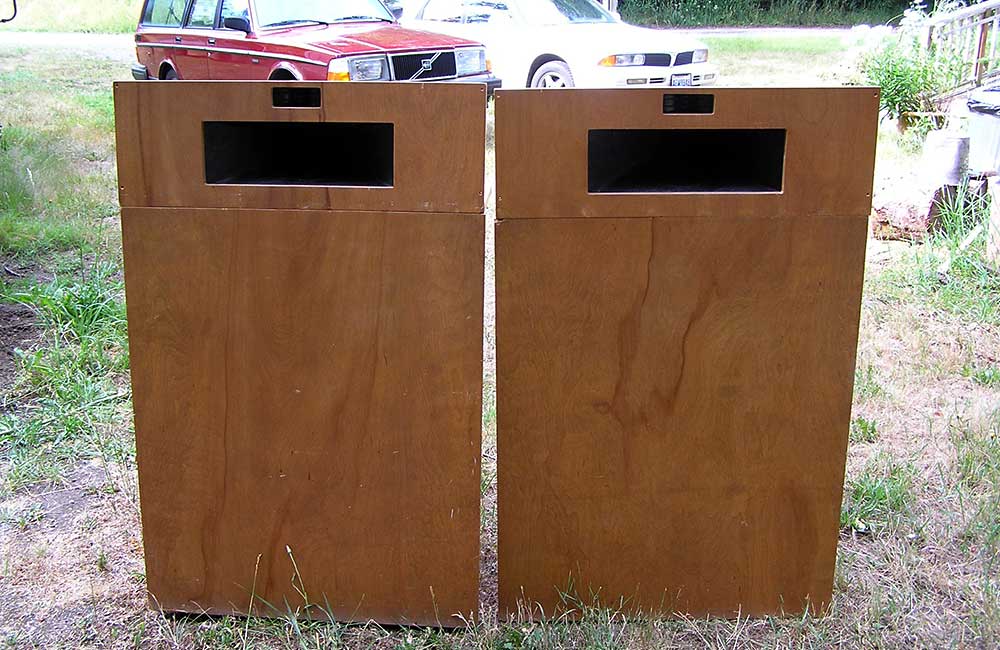
Photo above: A pair of vintage Klipschorn in birch for sale online. Image courtesy of Klipsch Audio Community.
Most buyers have been on the hunt for a suitable pair for months or longer and the effort, cajoling and pressing deadline tends to increase the excitement of acquiring these loudspeakers (and the telling of the story) as Klipschorn are high on the bucket list of most audio hobbyists. The cult-like following they’ve garnered over the past 70 years and passionate discourses regarding their sonics found online only adds fuel to unicorn-level status for a buyer.Record collector, New York brand ambassador for Discogs, former DJ and Brooklyn local (by way of England) Lloyd Evans spent four years looking for his perfect pair of Klispchorn after first being exposed to them through the Joy party collective when he arrived in New York City. “[It’s] a magical party that honours and respects the traditions of David Mancuso’s Loft,” said Evans. “I will always remember walking into the room and being struck by the balloons that adorned the celling, the unique styles of the dancers on the floor, but most of all the sound. It was like nothing I had ever heard before.”
Evans related how he spent time speaking with friends in the NYC scene who own Klipsch, reading forums and searching Craigslist/eBay for the right pair, saying he came close on a few of occasions, but would always just miss out. In the end he was able to score a pair of K-horns from an estate sale in upstate New York. “The owner – who I subsequently found out was well known locally for owning a timber company – had them installed in his cinema room. It was clear that he cared for sound as he had Klipsch Heresy throughout the rest of the house and I like to think that he’d be glad they’ve gone to someone who appreciates them. I have all the original paperwork including the price guide at the time, which is geeky but fascinating.”
Photos below: Images courtesy Lloyd Evans.

Evans with his vintage 1975 Klipschorn. “They’re slightly unusual in that they have feet that raise them up off the ground."
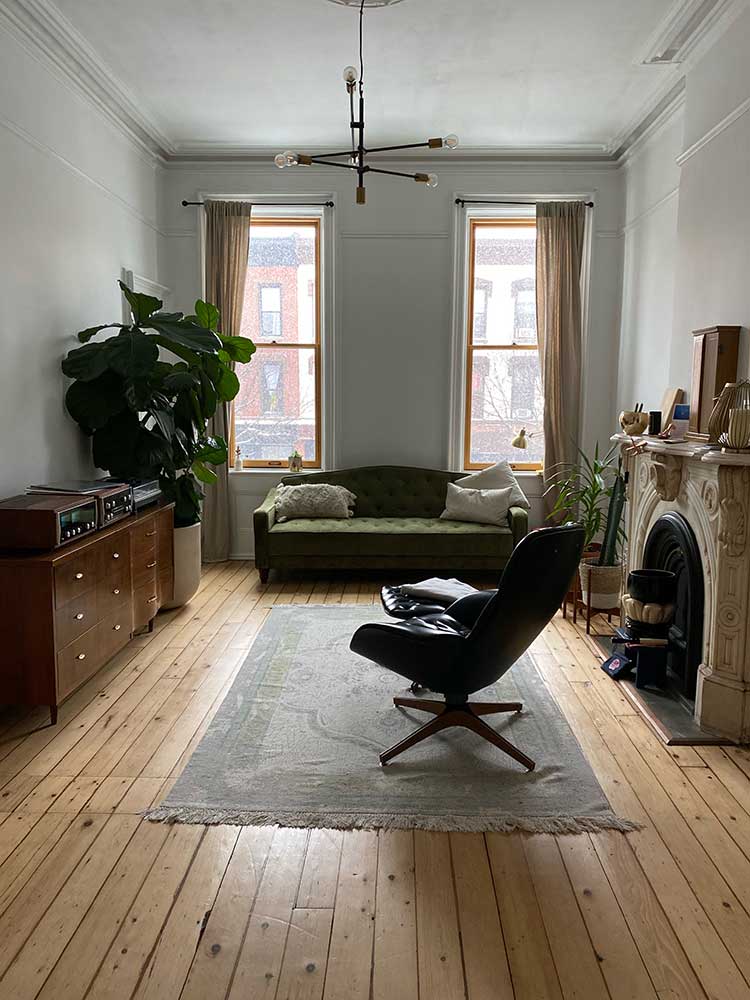
Because of their design, Evans was able to fit the K-horns in his Brooklyn loft. He runs them with vintage McIntosh gear.
“Their crystalline and immersive sound reveals the most minute production details and continues to shed a new light on classic tracks in my collection."
–Lloyd Evans
Evans said his pair are vintage 1975 and look/sound incredible given their age. “They’re slightly unusual in that they have feet that raise them up off the ground by an extra two inches but other than that, they are stock. If I do make any modifications, the logical thing would be to upgrade to Bob Crites crossovers.” According to Evans, the speakers have had a profound effect on the music he listens to. “Paul Klipsch designed the Klipschorn because he wanted to recreate the sound of a symphony in the living room and there’s been numerous times when I’ve felt that the artist is in the room with me.
“Their crystalline and immersive sound reveals the most minute production details and continues to shed a new light on classic tracks in my collection. For example, I find myself listening to Dexter Wansel’s "Life on Mars" or Alton McClain & Destiny’s "My Destiny" and hearing parts of the arrangement in a completely different light. It’s also influenced the music I buy – I subconsciously prefer certain tracks as I know they will sound even better on my set up.”
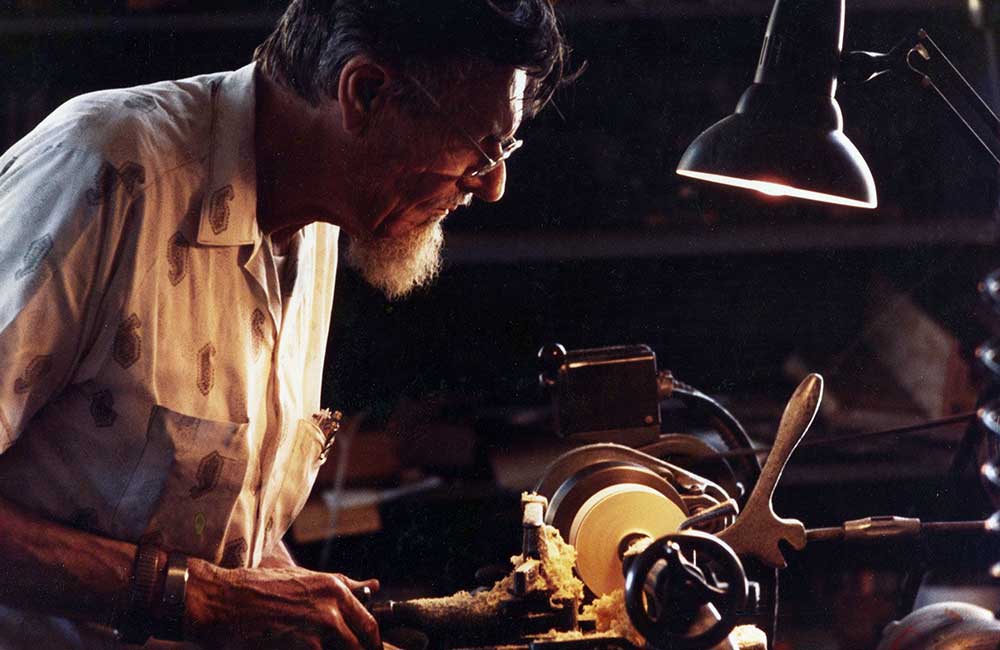
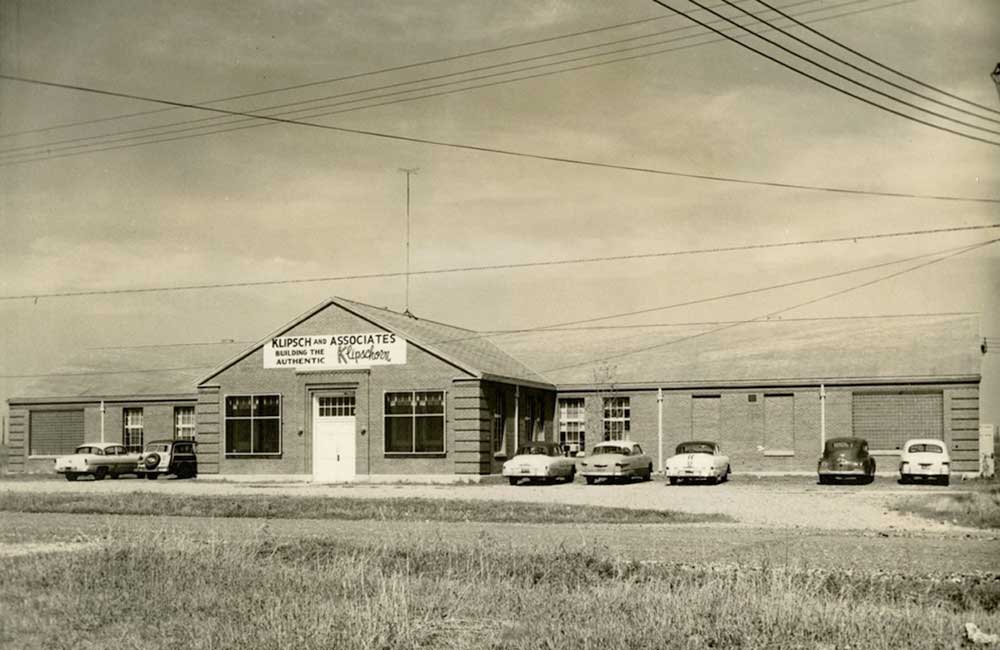
Photos above: Left – Paul Klipsch in an undated photo from the '70s. Right – Buildings at the USAF Southwest Proving Grounds that Klipsch bought for the factory. Images courtesy Klispch.
The story of the Klipschorn starts with Paul Klipsch, an American electrical engineer who took it upon himself to design and build the best sounding box he could. Klipsch had several careers that touched on acoustics, measurements and recordings in one form or another (designing radios for General Electric, maintaining locomotives, geophysicist for a Texas oil company and a Lieutenant Colonel in the U.S. Army where he calculated sonic waves and vibrations of ballistics), so he came by his passion for high fidelity honestly. He started on initial sketches and prototypes in earnest during the late ‘30s after constantly being disappointed with the lack of playback realism in then-current loudspeakers. Choosing (novelly at the time) to apply scientific measurement principles in developing the speaker system, his efforts and refinements to the folded-horn, corner-loaded design he came up with garnered him several patents between 1942 and 1945.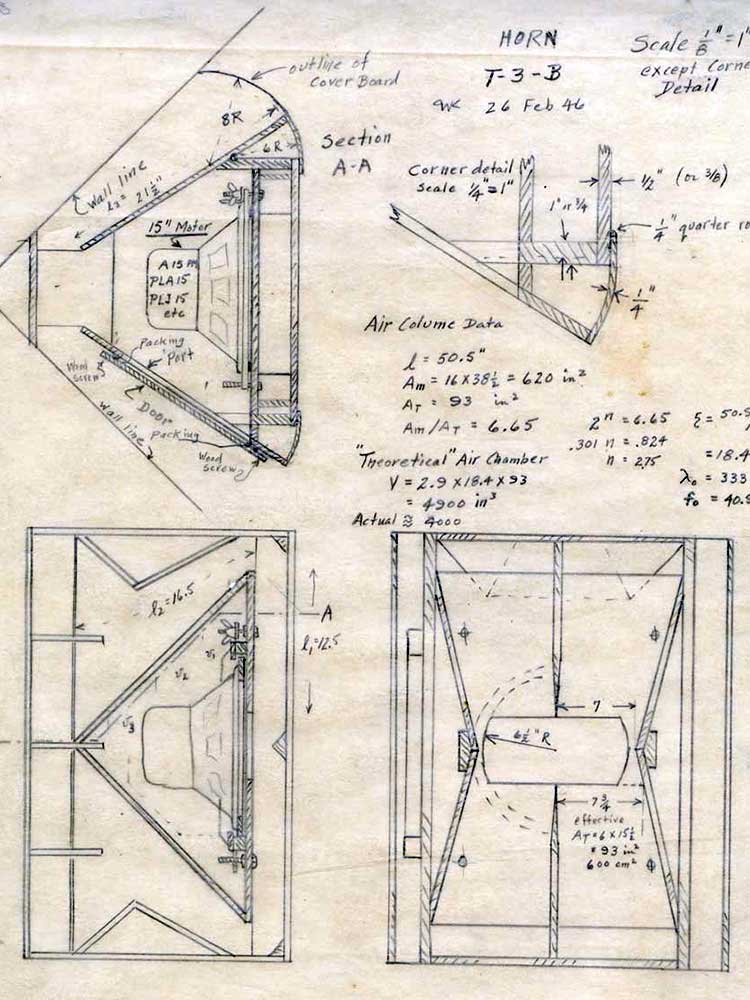
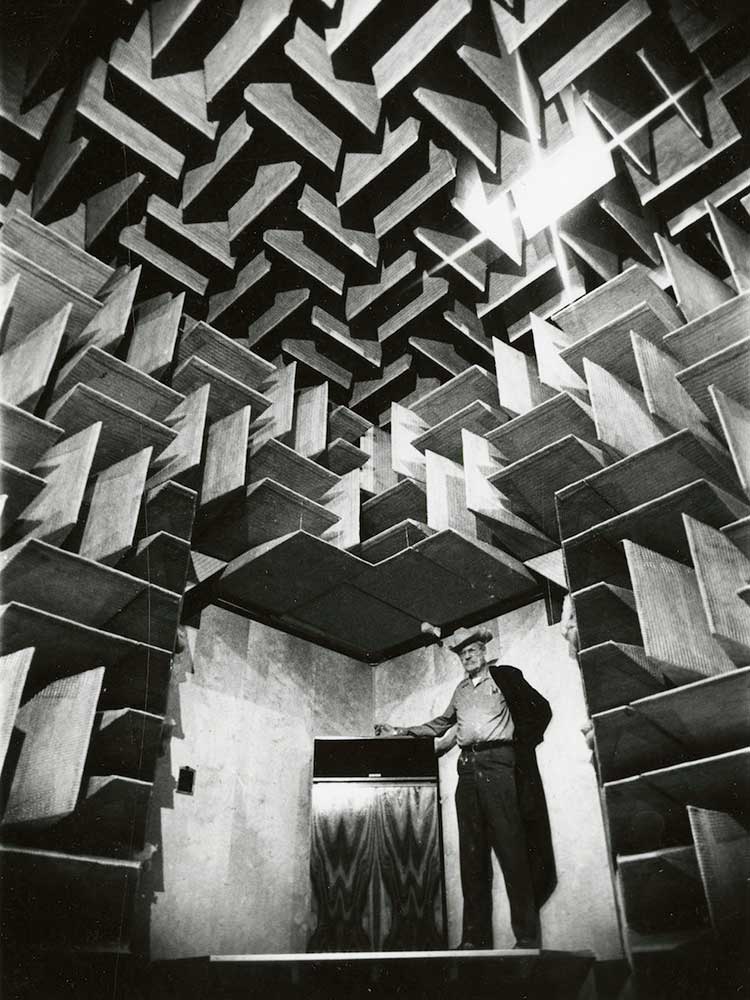
Photos above: Left – Early drawings of the K-horn from the late '30s or early '40s. Right – Klipsch in an anechoic chamber in an undated photo from the '80s. Images courtesy Klispch.
In 1946 Klipsch & Associates was formed and Klipsch commissioned the Baldwin Piano & Organ Company of Cincinnati, Ohio to construct the initial run of 12 units (Serial No. 2 to 13). According to company history this first batch were equipped with Western Electric WE713A high-frequency drivers and possibly JBL woofers. Late ’47 and early ’48 saw seven more units built (Serial No. 14 to 20) in a local Hope, Arkansas cabinet shop. Klipsch remarked that no two pairs were alike in the first few months of builds as he perfected the design and moved production around. He finally struck a deal to acquire the former telephone exchange buildings at the United States Air Force Southwest Proving Grounds where the current factory still stands. Records show that June 1, 1948 was the day the first Klipschorn – Serial Number 121 – was completed in the new Klipsch factory, alternately confounding and delighting audiophiles and music lovers ever since.Strictly speaking, the design is best expressed as a “bifurcated trihedral exponential wave transmission line” with the floor and walls completing the trihedral corner. Klipsch’s ingenious cabinet configuration, which initially used more than 350 screws to secure the hand-cut boards together, forms the “K-Horn,” which is a diamond shape. The front is a flat wood panel, the rear an exposed point with the top covered in a cloth grille. The driver is situated at the intersection of two adjoining baffles, and the whole chassis tuned to use wall and floor boundaries to extend the range of the folded horn. Looked upon as transformative in the way it utilised the room for more realistic loading, the folded-horn also allowed expression through low frequencies (down to roughly 35Hz) not seen in such a compact design previously.
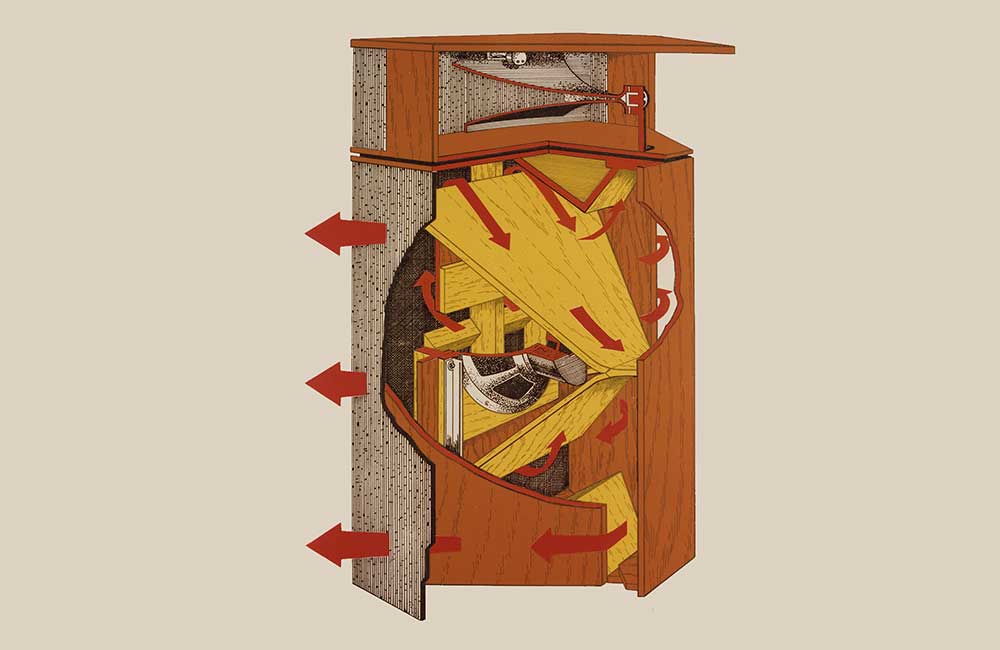
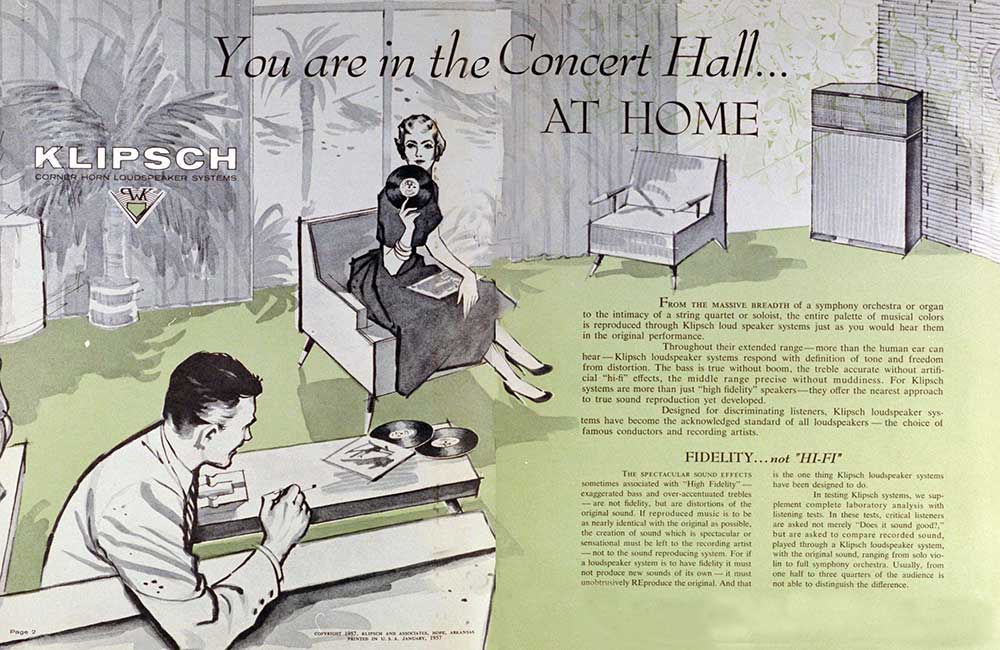
Photos above: Left – A Klipschorn cutaway showing the 'bifurcated trihedral exponential wave transmission line' construction. Right – A vintage Klipsch ad from the late '50s or early '60s.
Known for a huge sound stage, lifelike and effortless reproduction at high volume levels due to extreme efficiency (106dB at 1w/m), the design promoted a sonic experience which was unparalleled for in-home usage when introduced. Their responsiveness and nominal eight-Ohm impedance also meant low-powered tube amplifiers, even 2a3 designs outputting three or four watts, could easily drive the Klipschorn to concert-like SPL. Despite their dimensions (53-inches high, 31-inches wide and 28-inches deep), the fact they were meant to be pushed into corners made them relatively unobtrusive when compared to the large stand up furniture-style radios of the day. Over the decades Klipschorn became synonymous with a massive sound field, in-room realism and presence, effortless dynamics, outstanding resolution, and true-to-life tone and timbre reproduction. Other speaker manufacturers did what they could to try and emulate these traits, with some achieving varying degrees of success, but none managed to captivate listeners in the same way, leading to the design's cult-like following.The basic Klipschorn design – three-way with 15-inch woofer handling bass, horn-lensed compression driver squawker and tweeter handling midrange and treble respectively – has not altered much in seven decades (excepting for the decision in recent years to close the rear of the horn to make the speakers less dependent on full corner placement), but it has seen dozens of tweaks and production-associated component streamlining or replacements. Midrange and treble drivers have all incorporated various manufacturers over the years including Western Electric, JBL, Jensen, Stephens, Electrovoice, Atlas and Eminence to name several. Material use shifted over time as new alloy, plastic and electronic circuitry developments accommodated simplified production processes, improved frequency response, reduced measured distortion or resulted in better sound per design-team listening tests.
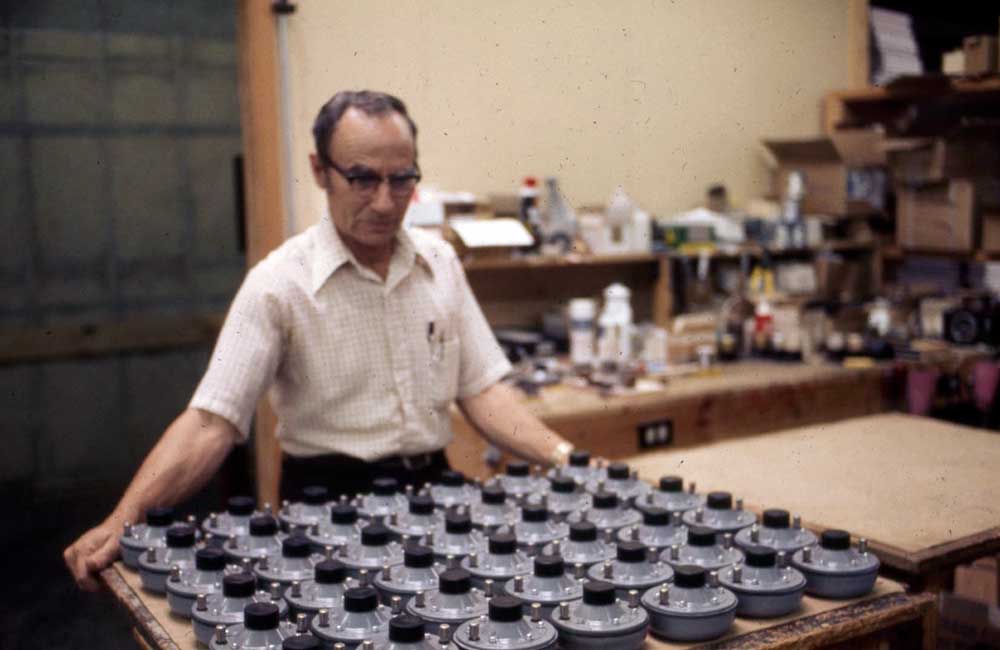
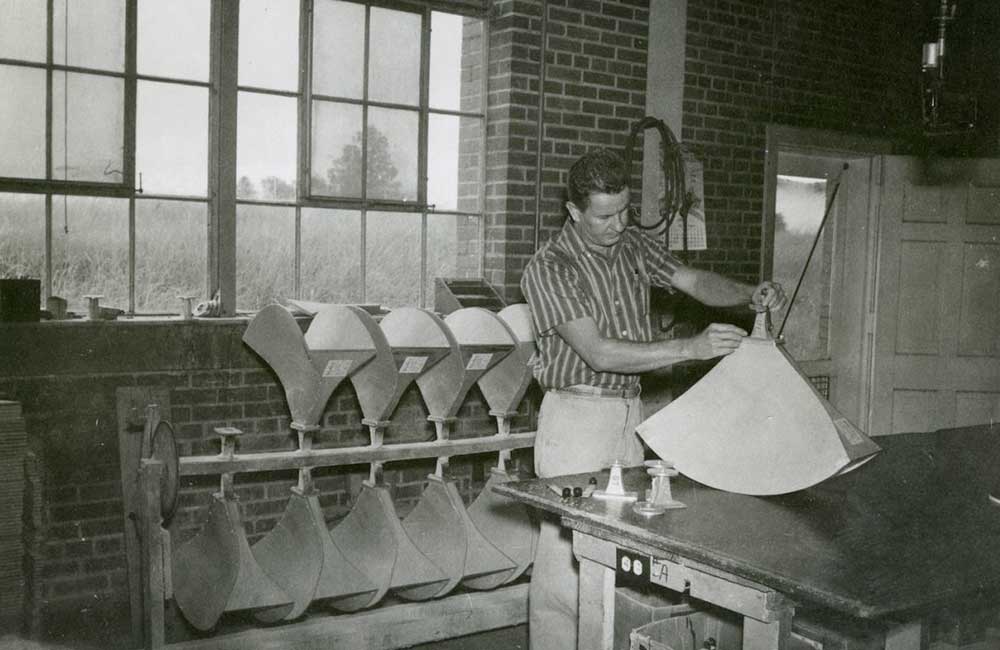
Photos above: Inside the original Klipsch factory location through the years. Images courtesy Klispch.
Examples of some changes include the large midrange horn, which was initially formed wood, then metal, finally transitioning to braced fibreglass. The tweeter was also relocated to the front of the cabinet in the early ‘80s. In person, the swaths of plywood (in early examples) or book-matched veneer that greet the listener on approach speak to a fetishist-level aesthetic of hand built craftsmanship and it’s impossible to not be impressed by so much grain. Their scale infers an imperturbable presence – completists take note – they tend to finalize any room they’re in, as if those particular corners were waiting to be filled by 200 pounds (each!) of wood, steel, fibreglass and electronics.This immersive soundfield quality, scale and dynamics of Klipschorns along with their ability to be tucked into corners no doubt contributed to David Mancuso using them in the ‘70s when he launched his world famous Loft parties as mentioned by Evans (if you’ve not been exposed to these legendary get togethers, a great introduction is the 1999 4xLP box set curated by Mancuso and cohort Colleen Murphy available HERE). Klipschorn afforded more dance floor space and their inclusion in the signal path speaks to how far Klipsch’s design migrated through, and cross-pollinated listening styles since their introduction. To go from ‘40s American home-furniture behemoth to disco infiltrator in 30 years is demonstrative of how K-horns became internationally recognized for their musical abilities from one generation to the next. Mancuso’s parties continue today amid strict fealty to the original aesthetic – still using Klipschorn.
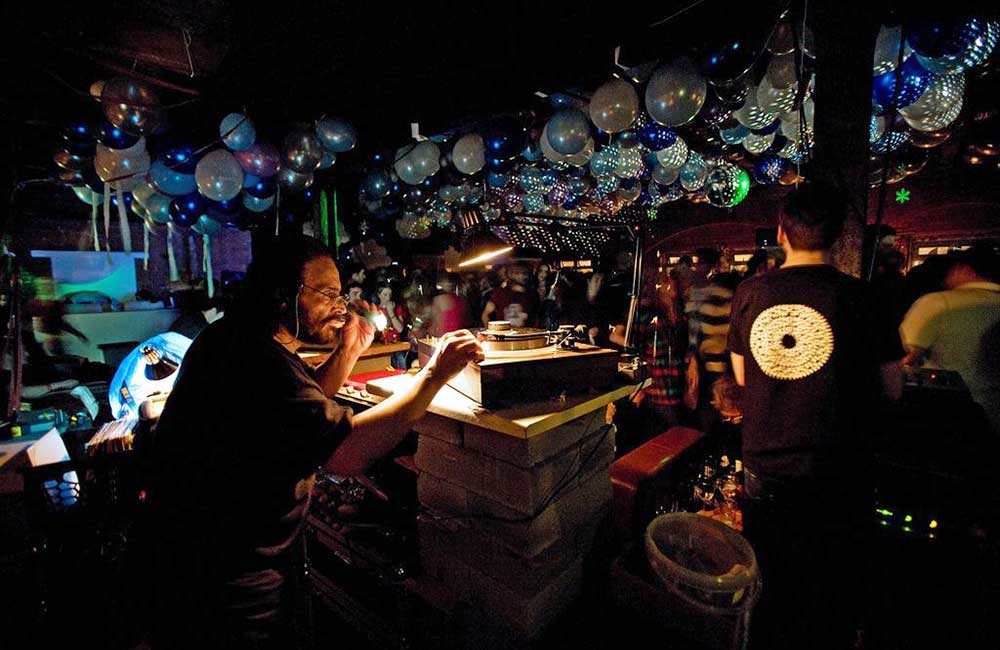
Photo above: David Mancuso spinning at a UK Loft party in The Light Bar sometime between 2003 and 2011. Image courtesy Pinterest.
If you’re not familiar with Los Angeles slow music bar In Sheep’s Clothing, you should take the time to do just that. Emmy nominated music supervisor, record label veteran, DJ and crate digger Zach Cowie helped set it up, and their updated playlist is well worth keeping tabs on for LP suggestions. Cowie said he got his first pair of Klipschorn just over a decade ago, “Like most of us, the speaker was on my radar due to the David Mancuso/Loft connection… but I’d never actually heard them, then I spotted a pair on Craigslist in Palm Springs which weren’t particularly well described and had a bit of a hefty price-tag.” He watched them sit on the site for months with no action before waking up on New Year’s day impulsively texting the seller a cash offer with the added bonus of ‘will pick up today’. “To my surprise they quickly responded with a ‘yes' and I was off to sort out a U-Haul rental."Once loaded into the truck and brought back to Los Angeles, Cowie was met with the sad reality that he couldn’t fit them through the front door of his small Venice Beach house. “I called my DJ partner Elijah to tell him what I’d done and asked if I could store them in his guest house until I sorted out a plan… Like a good DJ partner, he agreed and we unloaded them for a proper listen.” Cowie was clear that nothing can prepare a person for the first session with a K-Horn. “It creates one of those rare ‘hi-fi moments’ that you’ll spend the rest of your listening-life chasing. Such was the case for Elijah and I.” It wasn’t long before he sorted out a loft in downtown LA to accommodate the speakers. “Am I the first person who moved just so they could have K-horns? I doubt it,” laughed Cowie. Summing up, he added, “About six years ago I got restless and ventured into Altec-land, but my love of the K-horn remains strong. I'm certainly glad I know where my old pair ended up…”
Seven decades is a lifetime in human terms and an eternity in technological longevity. Few other electronic conveniences designed and built 70 years ago are still as relevant now as then. That a loudspeaker created in the time of Eisenhower evokes reverence in 2021 is not necessarily surprising, that it has been rolling off production lines relatively unchanged since before Ike was president is. Garrard turntables, Western Electric amplifiers and QUAD electrostatic speakers, for example, are just as revered and are almost as old – or older – than the Klipschorn, but none have been in continuous production. While some may remark that our current digital age signals an end to massive horn loudspeakers as dematerialised music, wireless/active speaker systems and the mobile-phone-as-source dominate the market. I say that 30 years from now people will still be borrowing a van and rallying friends to help pick up a pair of Klipschorn found online because, “there’s not much time.”


